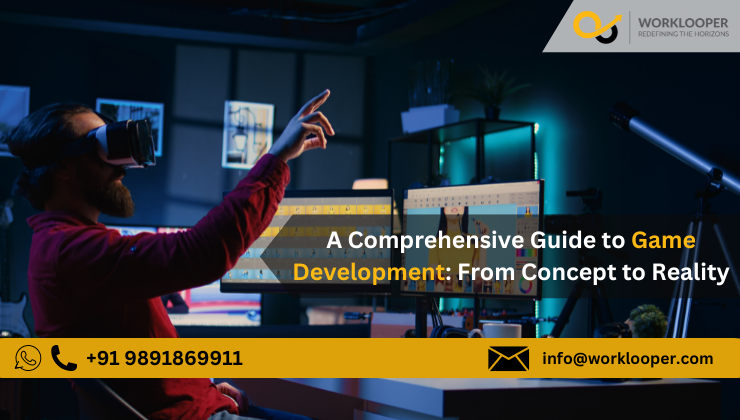
In the ever-evolving world of entertainment, a game development company stands out as one of the most dynamic and innovative fields. It blends creativity, technology, and storytelling to produce interactive experiences that engage millions of players worldwide. Whether you’re an aspiring game developer or simply curious about how games are made, this blog will take you through the essential stages of game development, from concept to reality.
1. Conceptualization: Where Ideas Come to Life
Every game starts with an idea. This could be a simple concept for a mobile puzzle game or an elaborate storyline for an open-world adventure. During the conceptualization phase, developers and designers brainstorm ideas, decide on the game’s genre, and envision how players will interact with the game.
Key questions during this phase include:
- What is the core objective of the game?
- What makes it unique?
- Who is the target audience?
For example, a game aimed at children will have vastly different mechanics and visuals than one targeting hardcore gamers.
2. Pre-Production: Building a Solid Foundation
Once the concept is solidified, the next step is pre-production. This phase involves:
- Game Design Document (GDD): A blueprint for the game that outlines gameplay mechanics, storyline, characters, levels, and features.
- Prototyping: Creating small, experimental versions of the game or its core mechanics to test feasibility.
- Team Formation: Assembling a team of developers, artists, sound designers, and writers to bring the project to life.
The goal of pre-production is to ensure that everyone on the team understands the vision and has a clear roadmap to follow.
3. Production: Bringing the Game to Life
This is where the real magic happens. The production phase involves the actual creation of the game and is often the longest stage in the process.
- Programming: Game developers write the code that powers the game. This includes the logic, physics, and AI behaviour that define how the game functions.
- Art and Animation: Artists create the visual elements of the game, from character designs to environment assets. Animators bring these elements to life with motion and expressions.
- Level Design: Level designers build the game’s worlds and stages, ensuring that they are fun, challenging, and visually appealing.
- Sound and Music: Audio plays a critical role in creating an immersive experience. Sound designers create everything from footsteps to background music, adding depth to the game’s world.
4. Testing: Ensuring a Seamless Experience
No game is perfect without rigorous testing. During this phase, the game is put through various tests to identify bugs, glitches, and other issues that could affect gameplay.
- Alpha Testing: The first round of testing, often done in-house, focuses on identifying major bugs and ensuring that the game’s core features work as intended.
- Beta Testing: This involves releasing the game to a limited audience to gather feedback and catch any remaining bugs before the full release.
Testing ensures that players have a smooth, enjoyable experience and that all technical aspects of the game function properly.
5. Post-Production: Refining and Launching the Game
Once testing is complete and all necessary fixes have been made, the game is ready for release. However, the work doesn’t stop there.
- Marketing: Promoting the game to build hype and attract players. This can include trailers, social media campaigns, and partnerships with influencers or gaming platforms.
- Distribution: The game is released on various platforms such as consoles, PC, or mobile, depending on its intended audience.
- Post-Launch Support: Even after launch, developers continue to provide updates, fix bugs, and release downloadable content (DLC) to keep players engaged.
6. Tools and Technologies in Game Development
Modern game development relies on a variety of tools and technologies to bring ideas to life. Some popular ones include:
- Game Engines: Unity and Unreal Engine are two of the most widely used game engines. They provide developers with the necessary tools to create, animate, and program their games.
- 3D Modeling Software: Tools like Blender, Maya, and 3ds Max are used to create detailed character models, environments, and objects.
- Sound Design Software: Programs like Audacity, FMOD, and Ableton Live help developers create immersive audio experiences.
7. The Future of Game Development
The future of game development is exciting and ever-changing, with new technologies continuously shaping the industry. Trends like virtual reality (VR), augmented reality (AR), and artificial intelligence (AI) are expanding the possibilities of what games can do. Additionally, the rise of cloud gaming and streaming platforms is making games more accessible than ever before.
As more people enter the world of game development, the opportunities to create innovative and engaging games will continue to grow.
Read More: Graphic Design Services
Conclusion
Game development is a complex and rewarding process that requires creativity, technical skills, and collaboration. From the initial idea to the final product, every stage plays a crucial role in crafting an experience that captivates players. Whether you’re interested in becoming a game developer or simply want to appreciate the work that goes into your favorite games, understanding the development process offers valuable insights into one of the most exciting industries today.
By mastering the fundamentals of game development and keeping up with the latest tools and trends, anyone can be part of this dynamic world and contribute to creating the next big hit in gaming.